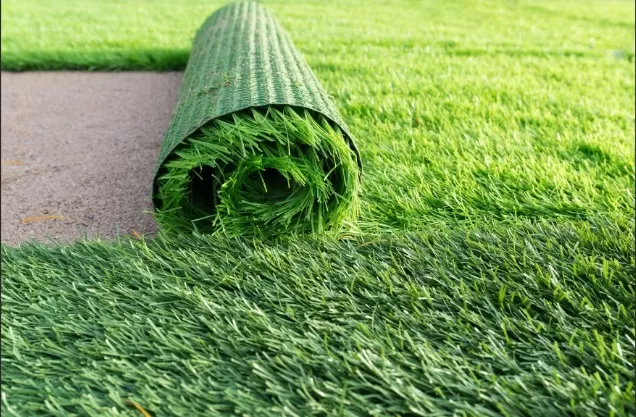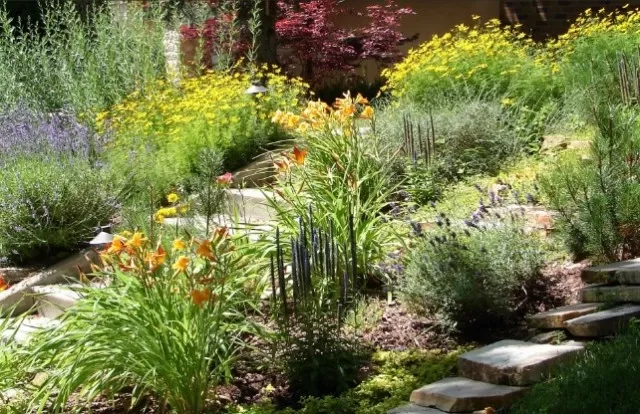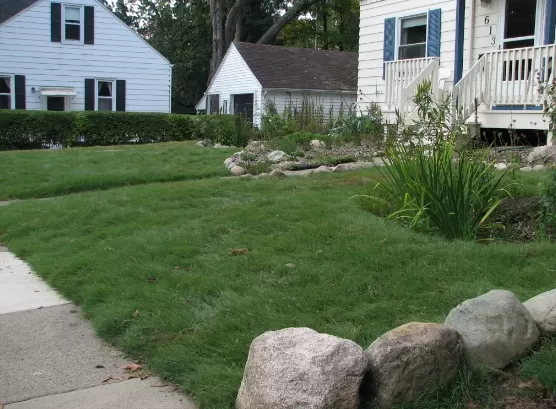Lawn Makeover: Easy Alternatives to Grass for your yard. If you’re eager to part ways with your traditional grass lawn, there are numerous alternatives available that not only reduce water consumption but also minimize the time and effort required for upkeep.
By exploring these grass alternatives, you can significantly reduce water consumption and the time spent on lawn maintenance. Choose an option that aligns with your preferences, climate, and environmental goals. Don’t hesitate to consult with local gardening experts or landscapers for advice on selecting the most suitable alternative for your specific area. Get ready to transform your outdoor space into a beautiful, water-efficient, and low-maintenance landscape.
Why You Should Consider Sustainable Lawn Alternatives and Take Steps to Reduce Water Usage

With the increasing frequency of drought patterns and water shortages becoming a reality in many American cities, it is crucial for all of us to consider adopting sustainable practices for our lawns and landscaping.
Did you know that depending on where you live, a significant portion, ranging from 30 to 50 percent, of your household water usage is dedicated to maintaining turf and other landscaping elements?.
To address this issue, it’s important to dispel a common misconception about xeriscaping, which involves making landscapes more waterwise and suitable for the local environment.
Contrary to popular belief, xeriscaping does not mean completely replacing grass with gravel. Instead, it focuses on creating landscapes that require less water and maintenance.
Lawns that consist of excessive grass, the wrong type of grass, or grass in unsuitable areas end up demanding more water and care, which is not sustainable in the long run.
When you consider ways to reduce water usage and maintain your lawn more efficiently, there are several small steps you can take before exploring alternative low-maintenance options.
These steps include removing turf areas on slopes, where water tends to run off, as well as narrow strips of grass, particularly those in “nuisance strips” near the sidewalk. Additionally, evaluating whether your turf consists of high-water-use grass mixes is essential.
You can also remove grass in corners of the lawn or in awkwardly shaped areas that are challenging to water and mow. Eliminating grass along fences can further contribute to water conservation efforts.
However, it is important to keep appropriate areas of grass lawns, such as spaces where children play, as they help cool patios and the house.
Reducing the overall amount of grass on your property, especially in areas where it doesn’t thrive well, such as under trees, can make a significant difference in water usage and lawn maintenance.
However, if you feel overwhelmed or require assistance with these tasks, don’t hesitate to seek help from lawn service professionals. Many professionals offer free, no-commitment estimates and can guide you through the process of transitioning to a more sustainable lawn.
By considering sustainable alternatives and implementing these small steps, you can contribute to water conservation efforts, minimize your environmental impact, and potentially reduce your monthly water bills.
Let’s all do our part in creating a greener future for our communities.
Exploring Sustainable Alternatives to Traditional Grass Lawns
If you’re considering replacing your traditional grass lawn with a more sustainable option, there are various alternatives to choose from.
The ideal alternative will depend on factors such as the amount of lawn you want to replace, the climate of your region, the presence of shade or other yard conditions, and, of course, your personal preferences. To help you find inspiration and suitable plant selections for your space, here are some design ideas to consider:.
Native Turf Grasses:A significant reason why many lawns require excessive water is that the grass species chosen may not be well-suited to the local climate.
When looking to replace a water-intensive lawn, it’s worth considering native grasses that are adapted to your region. Some drought-tolerant options include buffalo grass, Bermuda grass, bahiagrass, and blue grama.
In particular, the Lady Bird Johnson Wildflower Center in Austin, Texas, has developed a native turfgrass mixture called Habiturf, specifically designed for the arid Southwest. This alternative closely resembles hybrid turf grasses in appearance and texture.
While native grasses generally require less water than non-native species, they still require some level of irrigation, mowing, and maintenance.
However, opting for a grass that is adapted to your region and climate will result in minimal effort and the most sustainable choice for any remaining turf areas in your landscape.
Low-Maintenance Ground Covers:Another option to consider is replacing grass with low-maintenance ground covers.
These can include a variety of plants such as creeping thyme, clover, moss, or sedum. Ground covers not only provide an attractive alternative to traditional lawns but also offer benefits such as erosion control and reduced maintenance requirements.
Before selecting a ground cover, ensure that it is suitable for your specific climate and yard conditions.
Native Wildflower Meadows:Creating a native wildflower meadow is an excellent choice for those looking to attract pollinators and add biodiversity to their landscapes.
Wildflower meadows consist of a mix of native flowering plants and grasses that require less water and maintenance compared to traditional lawns. They can provide a vibrant and dynamic display throughout the growing season while supporting local ecosystems.
Ornamental Gardens and Landscaping:Consider transforming your lawn into an ornamental garden or landscaped area with a variety of shrubs, trees, and flowers.
By incorporating diverse plant species, you can create a visually appealing and environmentally friendly space that requires less water and maintenance than a traditional grass lawn. Additionally, including native plants in your garden can support local wildlife and contribute to the preservation of indigenous species.
Remember, the key to selecting the right sustainable alternative is to choose plants that are well-suited to your region’s climate and soil conditions.
Consider consulting with local horticultural experts or landscaping professionals who can provide guidance and recommendations based on your specific location.
By embracing sustainable alternatives to traditional grass lawns, you can reduce water consumption, minimize maintenance efforts, support biodiversity, and create a beautiful and eco-friendly outdoor space.
Veronica

Veronica, also known as Speedwell, is an excellent choice for homeowners looking to replace grass with a sturdy and evergreen ground cover.
This diverse plant offers a range of options that can meet various landscaping needs. Once Veronica spreads, it forms a dense cover of small, succulent-like leaves and produces charming flowers in late spring to early summer.
Here are a few notable Veronica varieties:.
Veronica Snowmass (Blue-eyed Speedwell): This variety showcases tiny white-petaled flowers with blue eyes.
It remains low-growing, reaching a height of 1 to 2 inches. Veronica Snowmass is a reliable ground cover option.
Veronica Waterperry Blue: Growing slightly taller at around 5 inches, Veronica Waterperry Blue thrives in zones 4 through 8.
Its leaves display copper undertones, while the flowers feature lavender petals with white eyes.
Turkish Speedwell: With purplish-blue flowers and a height of nearly 2 inches, Turkish Speedwell adds a vibrant touch to your landscape.
It can tolerate a range of zones, making it a versatile choice.
Most types of Veronica prefer full sun and can thrive in zones 3 through 10.
Additionally, they are known for their resistance to deer, making them a suitable option for areas prone to wildlife browsing. Veronica’s low-growing nature allows it to fill in gaps or spaces between flagstones, creating an attractive and well-maintained appearance in your yard.
Once established, Veronicas generally require little to no maintenance, making them a convenient and hassle-free ground cover choice.
By selecting Veronica as a grass alternative, homeowners can enjoy the benefits of its resilience, evergreen foliage, and charming flowers.
Whether used between stones or in open spaces, Veronica is a versatile and low-maintenance option that can enhance the visual appeal of your outdoor area.
Consider Gravel as an Alternative for Neglected Yard Areas
If you have neglected areas in your yard, such as strips of grass along the side of the house or shady spots, replacing the grass with gravel can offer a simple and effective solution.
Gravel mulch serves as a low-maintenance option that works well around plants that thrive in heat and can tolerate lower water levels. Additionally, with some creativity, you can enhance the visual appeal by incorporating crushed fine or pea gravel, introducing color or patterns and creating functional pathways at the same time.
However, it’s important to exercise caution when using gravel in highly sunny spots, particularly near the west side of a house.
This is because gravel has the potential to increase temperatures around the walls of the house. While you may save on water usage by replacing grass with gravel, you might end up paying more to cool your home or unknowingly create uncomfortably hot conditions on your favorite porch or patio during the summer months.
It’s advisable to carefully assess the sun exposure and potential heat impacts before deciding to replace grass with gravel in specific areas.
Alternatively, you can explore other suitable options like native ground covers or low-maintenance plants that can provide shade and contribute to temperature regulation around your house.
By considering the potential drawbacks and limitations of using gravel, you can make informed decisions about its application in your yard.
While gravel can be an effective solution for neglected areas, it’s essential to strike a balance between water conservation and maintaining a comfortable and sustainable outdoor environment.
Embrace Raised Edible Gardens for Multiple Benefits

Transforming an awkward area of your lawn into a vegetable and herb garden with raised planters offers a range of advantages.
By utilizing raised beds, you can optimize water usage by filling them with soil that is specifically tailored to the needs of your plants, surpassing what the local soil may provide. This enables you to save water compared to traditional vegetable gardening methods.
Instead of wasting water on areas like the sidewalk next to oddly shaped sections of grass, you can efficiently water your vegetables using soaker hoses or a simple drip irrigation system, ensuring that the water goes directly to the plants and not to waste.
One of the most rewarding aspects of growing your own food is the potential cost savings and convenience it offers.
By having a vegetable and herb garden, you can reduce your grocery expenses and eliminate frequent trips to the store. Additionally, homegrown produce provides the ultimate freshness, taste, and nutritional value, as you can harvest the vegetables and herbs at their peak, right before consuming them.
It doesn’t get any more locally grown than that!.
Before diving into creating raised beds and replacing your lawn with edible gardens, it’s crucial to check local regulations regarding such setups, especially if you plan to place the beds in your front yard.
Some areas may have specific guidelines or restrictions regarding the use of front yards for edible gardens. Being aware of the rules ensures that you can embark on your gardening journey while complying with local regulations.
By embracing raised edible gardens, you not only enjoy the satisfaction of growing your own food but also contribute to water conservation, cost savings, and environmental sustainability.
It’s a rewarding and practical way to make the most of your yard space while providing fresh, nutritious produce for you and your family.
*The information is for reference only.